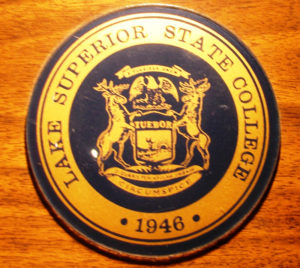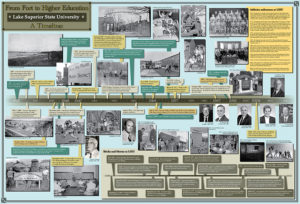 The area that currently makes up the campus of Lake Superior State University served as Fort Brady from 1894 to 1944; it is listed as “New Fort Brady” on the National Register of Historic Places.
The area that currently makes up the campus of Lake Superior State University served as Fort Brady from 1894 to 1944; it is listed as “New Fort Brady” on the National Register of Historic Places.
In 1946, this educational institution was established to address the needs of returning World War II veterans and to provide advanced opportunities to the people of the Eastern Upper Peninsula. The 115-acre campus includes several buildings which are listed in the National Register of Historic Places. One such example of a historic building is Brown Hall. It was built in the 1820s. This building served as the captain’s quarters of Fort Brady. Remodeling of this hall took place in 1946. In the 1960s, Brown Hall was converted into a counseling and career center that provided academic advising. It was originally led by Steve Youngs and was later taken on by John Truckey. In 1982, it was called by its present name when it was named for the retired janitor, Edward J. Brown. It is now the location of the School of Education.
Built in 1903, South Hall was originally built to house Fort Brady’s infantry soldiers. The infantry barracks were originally composed of twin buildings. South Hall’s twin stood approximately 80 feet to the west of South Hall, and was known as the Forestry Building. The two buildings were connected by a third building, which was a one-floor 80 ft. by 40 ft. wooden structure consisting of an outer shell with a hard wood floor. The building was referred to as the “drill floor”. ROTC cadets practiced marching in the building during inclement weather; otherwise, drills took place outside on the parade grounds, which is where the Kenneth J. Shouldice Library now stands. The Forestry building was destroyed by fire in the early 1960s. The drill floor building was not damaged but was razed during the demolition of the Forestry Building. The floor itself was scavenged and sold. Prior to this time, South Hall was always referred to as the Library although the library only took up a portion of the building. The Campus Book Store used two floors before moving to the renovated Canusa Hall, which saw dining services move to the Cisler Center. There were other smaller structures used for classrooms but the three main buildings were the Library, the Forestry building and the Chemistry building. It would have been just north of the Center for Applied Sciences and Engineering Technology. The old Chemistry building was torn down in the 1970s. It had housed the Chemistry and Geology departments along with the Reserve Officers’ Training Corps (ROTC) and the school nurse. Chemistry and the sciences relocated to Crawford Hall upon its completion.
Business Operations, Financial Aid, Registrar, and Scheduling can all be found in the former gymnasium for Fort Brady and later, the Soo Tech Hornets. It was named after Lake Superior State University benefactor, H. Thayer Fletcher. Much of the known information about this building and many others on campus can be recovered from the Lake Superior State University Kenneth J. Shouldice Library Special Collections room.
The university’s upbringings can be credited to Michigan College of Mining & Technology, which is now known as Michigan Technological University. The original class consisted of 272 students. The institution was later renamed Lake Superior State College of Michigan Technological University in 1966. The college received autonomy from Michigan Technological University in 1970 and was known as Lake Superior State College until 1987, when the institution was granted university status.
Lake Superior State University was the first college in the United States to offer an accredited four-year fire science program, and continues to be one of only three universities to offer such a program.
Lake Superior State University is a personal, small-town school that provides a superior blend of liberal and technical studies in the natural setting on Michigan’s Upper Peninsula. Lake Superior State University offers undergraduate degrees in 45 areas of study that attract students from every county in Michigan, more than a dozen states and provinces, and nine nations. Lake Superior State University is Michigan’s most personal public university emphasizing an undergraduate experience provided by a fully-qualified faculty and a dedicated staff. The institution is also one of only three universities in the United States to offer the robotics specialization in the Accreditation Board for Engineering and Technology/Technology Accreditation Commission (ABET/TAC). This includes the accredited manufacturing engineering technology, electrical engineering, computer engineering, and mechanical engineering bachelor of science degrees. Lake Superior State University is home to one of the best robotics educational facilities in North America. The robotics laboratory is valued at over $3 million.
 In 2010, Lake Superior State University launched its Creative Writing program, which focuses on poetry, prose, and performance writing. This program augments the twin Saults’ strong artistic communities. The program’s “Visiting Writer Series” brings accomplished writers to the campus to read their work and hold master classes with students and aspiring area writers. An international literary journal called “Border Crossing” was founded by Creative Writing faculty members at Lake Superior State University to showcase poems, short stories and essays. The journal’s title references the International Border between the United States and Canada, near where Lake Superior State University sits. The English Club also produces a student literary journal called “Snowdrifts”.
In 2010, Lake Superior State University launched its Creative Writing program, which focuses on poetry, prose, and performance writing. This program augments the twin Saults’ strong artistic communities. The program’s “Visiting Writer Series” brings accomplished writers to the campus to read their work and hold master classes with students and aspiring area writers. An international literary journal called “Border Crossing” was founded by Creative Writing faculty members at Lake Superior State University to showcase poems, short stories and essays. The journal’s title references the International Border between the United States and Canada, near where Lake Superior State University sits. The English Club also produces a student literary journal called “Snowdrifts”.
The university’s college radio station is WLSO. It can be found at 90.1 on the FM Band. You can also listen to it online. If you wish to send a request, call the broadcasting center located in room 105 of the Walker Cisler Centre, by dialing 635-2863. Another informative tool is the student’s newspaper The Compass. It is Lake Superior State University’s student-run newspaper. Distributed each week during the academic year, The Compass is written, edited, and produced by students. The press room is located in room 107 of the Walker Cisler Centre. You can get your free copy at various locations on campus.
Poised for growth, the Lukenda School of Business at Lake Superior State University will find a permanent home at the completion of a multi-million dollar construction project to renovate South Hall. Privately raised funds, plus a 3-to-1 match from the project’s largest funding source – the State of Michigan – will complete the renovation and revitalization project with SoHO: The South Hall Opportunity. The facility will serve as a destination point for students, scholars, leaders and executives-in-training, and provide a literal and figurative heart for the School of Business to collaborate on joint ventures and partnerships for important strategic initiatives. The renovated South Hall will promote a sense of permanence and commitment to the future of the School of Business and the university.
Lake Superior State University has a variety of traditions. Here are just a few to get you started.
Banished Word List
Each New Year brings another installment of the school’s “List of Words and Phrases Banished from the Queen’s English for Mis-Use, Over-Use, and General Uselessness.” It has been going strong since New Year’s Day 1976 and receives significant media coverage. Word-watchers pull nominations throughout the year from everyday speech, as well as from the news, fields of education, technology, advertising, politics, and more. A committee gathers the entries and chooses the best in December. The list is released on New Year’s Day. Check out this year’s list of Banished Words.
Snowman Burning
Each March, on or near the first day of Spring, students, alumni and townsfolk gather around a 10 to 12-foot snowman on campus and light it on fire. The snowman burning is derived from a German tradition in which the mayor of the town burns a snowman to declare an end to winter. The snowmen are usually made out of recycled paper and wire. In 1992, the event was canceled due to protests from the Environmental Awareness Club, a student group at Lake Superior State University. This decision upset many in the community, and the tradition was resumed in 1993.
Hoholik/Husband Victory Bell
The bell hangs outside the gym entrance to the Norris Center. After each Laker win, the team switches skates to running shoes, pulls on ski caps, and charges down the halls of the building to sound the victory bell. The custom was started soon after the bell was hung in early 1980’s. Prior to the 1992-93 season, the bell, which sustained extensive damage from the 1992 NCAA Championship celebration, was replaced with one from a West Troy, New York church.
Ship’s Horn
This is the nemesis of all opposing goaltenders at the Taffy Abel Arena. The authentic ship’s horn is mounted high on the wall behind the goal the visitors defend for two periods. It blasts for each Laker goal and following all home games. The horn operates on compressed air.
Laker Week
Laker Week has been a yearly tradition to welcome back students. It begins on freshman move-in day each year in August and runs for approximately a week and a half. Events include movie on the lawn, Mackinac Bridge walk and a variety of other events to get students acquainted with the University. It’s also a great way to meet new friends!
Winter Carnival
Similar to Laker Week, Winter Carnival happens every January a week after the students return from semester break. It’s a week full of various events and gets students back in the swing of things!
Volunteers available from LSSU
The purpose of the Lake Superior State University Volunteer Center is to promote civic engagement in the LSSU and larger communities through volunteer and service opportunities. One of our primary goals is to weave the spirit of service into the fabric of Lake Superior State University. They do this by providing ongoing programs like the Michigan Service Scholars, by informing the student body about episodic volunteer opportunities for those who want to make a big difference in a short amount of time, and by connecting students to community organizations that match best their skills and interests. The LSSU Volunteer Center was formally established in 2006, as a satellite office from the United Way of the Eastern Upper Peninsula. Through this partnership with the United Way, the Volunteer Center is growing by leaps and bounds. Everybody in the community is invited to make use of the resources offered by the Volunteer Center.
Stop by and visit them in the Student Organization at the Cisler Center, send them an email to campuslife@lssu.edu or call the center at 635-2236.
SOURCE: www.lssu.edu
